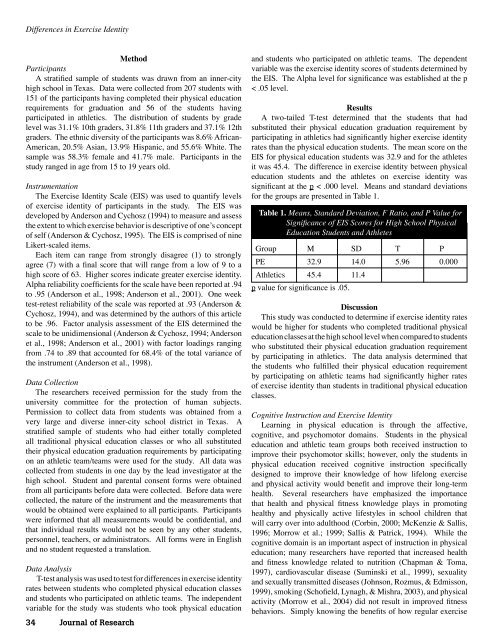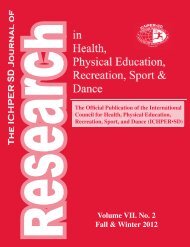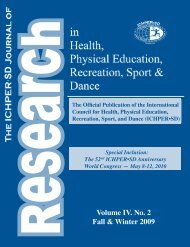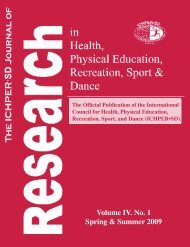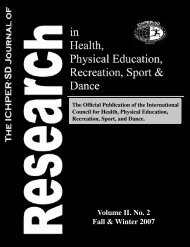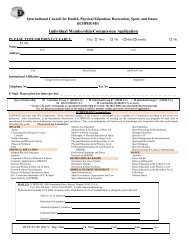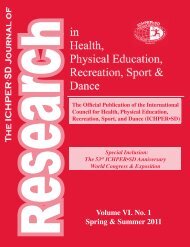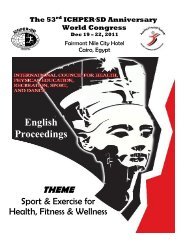Volume V. No. 1 Spring & Summer 2010 - ichperâ¢sd
Volume V. No. 1 Spring & Summer 2010 - ichperâ¢sd
Volume V. No. 1 Spring & Summer 2010 - ichperâ¢sd
You also want an ePaper? Increase the reach of your titles
YUMPU automatically turns print PDFs into web optimized ePapers that Google loves.
Differences in Exercise Identity<br />
Method<br />
Participants<br />
A stratified sample of students was drawn from an inner-city<br />
high school in Texas. Data were collected from 207 students with<br />
151 of the participants having completed their physical education<br />
requirements for graduation and 56 of the students having<br />
participated in athletics. The distribution of students by grade<br />
level was 31.1% 10th graders, 31.8% 11th graders and 37.1% 12th<br />
graders. The ethnic diversity of the participants was 8.6% African-<br />
American, 20.5% Asian, 13.9% Hispanic, and 55.6% White. The<br />
sample was 58.3% female and 41.7% male. Participants in the<br />
study ranged in age from 15 to 19 years old.<br />
Instrumentation<br />
The Exercise Identity Scale (EIS) was used to quantify levels<br />
of exercise identity of participants in the study. The EIS was<br />
developed by Anderson and Cychosz (1994) to measure and assess<br />
the extent to which exercise behavior is descriptive of one’s concept<br />
of self (Anderson & Cychosz, 1995). The EIS is comprised of nine<br />
Likert-scaled items.<br />
Each item can range from strongly disagree (1) to strongly<br />
agree (7) with a final score that will range from a low of 9 to a<br />
high score of 63. Higher scores indicate greater exercise identity.<br />
Alpha reliability coefficients for the scale have been reported at .94<br />
to .95 (Anderson et al., 1998; Anderson et al., 2001). One week<br />
test-retest reliability of the scale was reported at .93 (Anderson &<br />
Cychosz, 1994), and was determined by the authors of this article<br />
to be .96. Factor analysis assessment of the EIS determined the<br />
scale to be unidimensional (Anderson & Cychosz, 1994; Anderson<br />
et al., 1998; Anderson et al., 2001) with factor loadings ranging<br />
from .74 to .89 that accounted for 68.4% of the total variance of<br />
the instrument (Anderson et al., 1998).<br />
Data Collection<br />
The researchers received permission for the study from the<br />
university committee for the protection of human subjects.<br />
Permission to collect data from students was obtained from a<br />
very large and diverse inner-city school district in Texas. A<br />
stratified sample of students who had either totally completed<br />
all traditional physical education classes or who all substituted<br />
their physical education graduation requirements by participating<br />
on an athletic team/teams were used for the study. All data was<br />
collected from students in one day by the lead investigator at the<br />
high school. Student and parental consent forms were obtained<br />
from all participants before data were collected. Before data were<br />
collected, the nature of the instrument and the measurements that<br />
would be obtained were explained to all participants. Participants<br />
were informed that all measurements would be confidential, and<br />
that individual results would not be seen by any other students,<br />
personnel, teachers, or administrators. All forms were in English<br />
and no student requested a translation.<br />
Data Analysis<br />
T-test analysis was used to test for differences in exercise identity<br />
rates between students who completed physical education classes<br />
and students who participated on athletic teams. The independent<br />
variable for the study was students who took physical education<br />
34 Journal of Research<br />
and students who participated on athletic teams. The dependent<br />
variable was the exercise identity scores of students determined by<br />
the EIS. The Alpha level for significance was established at the p<br />
< .05 level.<br />
Results<br />
A two-tailed T-test determined that the students that had<br />
substituted their physical education graduation requirement by<br />
participating in athletics had significantly higher exercise identity<br />
rates than the physical education students. The mean score on the<br />
EIS for physical education students was 32.9 and for the athletes<br />
it was 45.4. The difference in exercise identity between physical<br />
education students and the athletes on exercise identity was<br />
significant at the p < .000 level. Means and standard deviations<br />
for the groups are presented in Table 1.<br />
Table 1. Means, Standard Deviation, F Ratio, and P Value for<br />
Significance of EIS Scores for High School Physical<br />
Education Students and Athletes<br />
Group M SD T P<br />
PE 32.9 14.0 5.96 0.000<br />
Athletics 45.4 11.4<br />
p value for significance is .05.<br />
Discussion<br />
This study was conducted to determine if exercise identity rates<br />
would be higher for students who completed traditional physical<br />
education classes at the high school level when compared to students<br />
who substituted their physical education graduation requirement<br />
by participating in athletics. The data analysis determined that<br />
the students who fulfilled their physical education requirement<br />
by participating on athletic teams had significantly higher rates<br />
of exercise identity than students in traditional physical education<br />
classes.<br />
Cognitive Instruction and Exercise Identity<br />
Learning in physical education is through the affective,<br />
cognitive, and psychomotor domains. Students in the physical<br />
education and athletic team groups both received instruction to<br />
improve their psychomotor skills; however, only the students in<br />
physical education received cognitive instruction specifically<br />
designed to improve their knowledge of how lifelong exercise<br />
and physical activity would benefit and improve their long-term<br />
health. Several researchers have emphasized the importance<br />
that health and physical fitness knowledge plays in promoting<br />
healthy and physically active lifestyles in school children that<br />
will carry over into adulthood (Corbin, 2000; McKenzie & Sallis,<br />
1996; Morrow et al.; 1999; Sallis & Patrick, 1994). While the<br />
cognitive domain is an important aspect of instruction in physical<br />
education; many researchers have reported that increased health<br />
and fitness knowledge related to nutrition (Chapman & Toma,<br />
1997), cardiovascular disease (Suminski et al., 1999), sexuality<br />
and sexually transmitted diseases (Johnson, Rozmus, & Edmisson,<br />
1999), smoking (Schofield, Lynagh, & Mishra, 2003), and physical<br />
activity (Morrow et al., 2004) did not result in improved fitness<br />
behaviors. Simply knowing the benefits of how regular exercise


